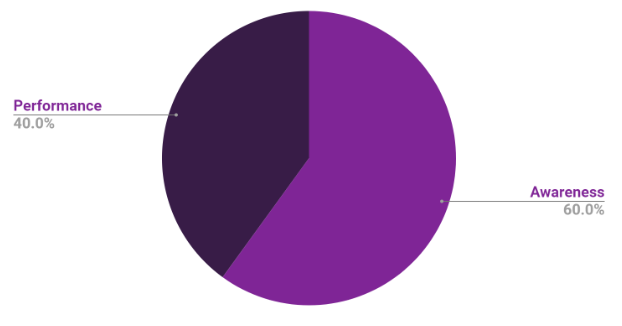The appearance of Connected TV (CTV) as a new marketing channel shows itself as an opportunity and a new challenge for marketers. Early understanding, testing, and innovation willingness will be key to leveraging CTV for growth.
With the participation of Gisjbert Pols from Adjust, Martha Masachs from Funplus, and Alfons Schwartz and Júlia Planas from Smadex, we hosted a webinar dedicated to answering the most significant questions about CTV.
We started by asking the audience what did they think is the most common use of CTV, and these were the results:

Since CTV is, at the end of the day, ads shown on TV, it’s normal to relate it more to awareness campaigns.
How can Connected TV become a performance channel?
Gijsbert from Adjust pointed out that one of the most significant advances is the digitalization of television. The ability to target audiences based on region, preferences, and more brings the capability to measure the outcome of advertising efforts, thus making it far more accountable.
Targeting and measurement are key words in the CTV discussion. Marta from Funplus explained that from the publishing side, they have seen that, compared to linear TV, measurement has improved a lot in the optimization processes. Everything has evolved thanks to the improvements in measurement and analytics available for CTV, from campaign setup to creative creation.
As an advertiser, how do you start testing, and when?
The decision to start testing CTV campaigns is tied to the context and situation of each advertiser. However, to begin on the right foot, here are a few tips:
- Find the right partner that can provide expertise in campaign optimization, deciding between an intermediary or a direct vendor. Intermediaries can be better to start with because they aggregate different vendors.
- Invest time in choosing the right creatives. You don´t necessarily need to develop new ones, as the ones you have already may work.
- Test in regions with higher CTV penetration, like the US, to gain better insights from the test.
- Work with a trustworthy measurement partner able to track CTV attribution.
Attribution models debate: Is last touch the best for CTV attribution?
Attribution in CTV campaigns is one of the biggest concerns for advertisers. Alfons from Smadex explained that currently, the most used model is last touch. However, this doesn’t mean that it is the only source of truth and that if you are not attributed, you didn’t help to make the user install the app. That’s why it is important to complement the attributed data with other ways of measurement:
- Have the proper measurement tools.
- Analyze the incremental installs.
- Have an assisted install dashboard.
Gijsbert pointed out that it is important to have a full-funnel perspective and be aware that even if last touch doesn’t sit easily on CTV, that doesn’t mean that it is not performing.
We wanted to illustrate how powerful CTV can be, especially for performance and UA, so we ran another poll to our audience and asked them if they use their phone and multitask while watching TV. 73% said yes. This shows that CTV can be a highly effective channel for UA campaigns because advertisers impact people actively using their mobile phones while watching their ads.
Does running a CTV campaign alongside an evergreen mobile UA campaign make sense?
The straightforward answer is yes. There are a few important things to keep in mind when combining these two channels to make the most of them. The idea is that the CTV campaign is an extra channel to leverage the mobile UA campaign.
The best way to find synergies between them is through IP retargeting. Mixing this with a good creative strategy will allow you to use data from one campaign to another to increase retention and the number of users that install the app. For example, combining a playable ad on their mobile phone and analyzing the user’s behavior to take the ones that interacted with the playable and then retargeting the user with a CTV video ad that shows them new features of the game, can help to make the user ends up installing the app.
Creative tips for CTV campaigns
- Repurpose one of the creatives that have proven successful in other UA channels when testing CTV.
- Include a voice-over and a clear call to action at the end.
- Have a 30-second and 50-second version of the ad to adapt to the channel.
What about including QR codes? Do they help?
According to our Adjust guest, Gijsbert, QR codes do help, but not in the way most people expect them to. They have noticed that CTV ads that include QR codes perform better, not because people actually scan the codes but because they become aware that they are watching an ad for a mobile app.
How can you measure the impact of your CTV campaign in your UA?
When analyzing the impact of CTV campaigns in UA, keep in mind the following:
- A small test might have a small impact.
- Assisted installs can help you identify how CTV campaigns impacted other sources.
- Keep in mind a full-funnel perspective and ask yourself if Connected TV is driving audiences to lower funnel channels and do they convert.
Embrace the opportunity of CTV!
With Connected TV, advertisers can set their campaigns on their own parameters for budget, goals, time of day, and geos. TV advertising is exponentially growing as an opportunity to engage customers by combining the perks of online advertising with the reach of TV. It offers many benefits inherent to its nature that advertisers can’t find in any other channel.
Follow the link to access the full webinar recording and get in touch if you want to know more about our Smadex for CTV Solution.
You might also find interesting:
- Success story: Utilizing CTV AdVision to top the most downloads game list in 142 countries
- Success story: CTV: The Opportunity to Amplify Your Brand
